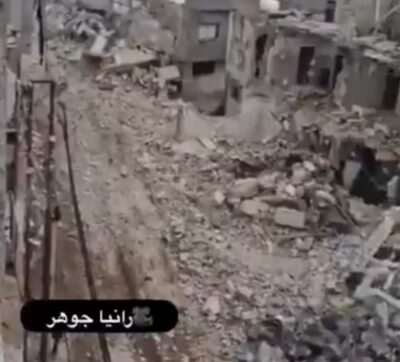The ongoing Israeli offensive on Tulkarem and its refugee camps, in the occupied West Bank’s northwestern part, has now reached its 25th consecutive day, with the Nur Shams refugee camp facing its 12th day of siege. The military escalation includes increased reinforcements and the destruction and burning of homes.
Media sources reported that the Israeli army deployed additional brigades in the city and its refugee camps, deploying infantry troops throughout the eastern and northern neighborhoods, and around the entrances of the Tulkarem and Nur Shams refugee camps.
The sources added that the soldiers fired live ammunition, sound bombs, flares, and smoke grenades, resulting in massive explosions.
 Infantry brigades, backed by military vehicles, have extensively spread through the city’s neighborhoods, setting up military roadblocks around the Younis roundabout in the northern neighborhood, the Abu Safiya junction in the eastern neighborhood, and Nablus Street, which connects Tulkarem and Nur Shams refugee camps.
Infantry brigades, backed by military vehicles, have extensively spread through the city’s neighborhoods, setting up military roadblocks around the Younis roundabout in the northern neighborhood, the Abu Safiya junction in the eastern neighborhood, and Nablus Street, which connects Tulkarem and Nur Shams refugee camps.
They stopped and searched vehicles, checked passengers’ ID cards, and assaulted many young men.
The soldiers continue to occupy many homes in the eastern neighborhood of the city, particularly in the Abu Safiya junction and Muqata’a Street areas, turning them into military bases and sniper posts. This has severely restricted residents’ movements, preventing them from leaving their homes.
The army also occupied two homes on Nablus Street, adjacent to the Tulkarem camp, with soldiers deployed around them.
At dawn, the soldiers abducted Khaled Balidi after storming his home in the southern neighborhood of the city.
In Tulkarem refugee camp, Israeli forces continued demolishing homes, leveling them to the ground as part of an escalation campaign targeting it.
It is worth mentioning that the army plans to demolish 14 additional homes under the pretext of opening a street extending from the UNRWA area to the Balawna neighborhood, passing through the neighborhoods of Sawalma, Ash-Shuhada, and Al-Khadamat.
Israeli forces also set other homes on fire within the refugee camp, with columns of smoke rising. Many homes and buildings have been demolished or damaged, and other homes were burnt due to the ongoing offensive, an issue that threatens hundreds of surrounding homes, in addition to the massive destruction of infrastructure, including water, sewage, electricity, and communications.
The Popular Committee for Services in Tulkarem refugee camp reported that 50 homes were destroyed, and 90% of the refugee camp’s residents have been forcibly displaced by the occupation.
On Wednesday, the occupation forces gave the residents only two hours to evacuate their homes before demolishing them, displacing dozens of families who were forced out of their homes, racing against time, carrying what they could from their partially destroyed buildings, while the occupation forces surrounded the area and densely deployed foot patrols between the alleys and inside some homes turned into military barracks.
In the same context, Israeli forces continued to deploy foot and mobile patrols in the neighborhoods of Nur Shams refugee camp, which is under tight siege. They fired flares and live ammunition extensively, raided homes, converted them into military barracks, and carried out extensive explosions inside the camp, especially in the Manshiyya neighborhood.
The soldiers also continued to close the Jabara military roadblock’s gate at the southern entrance to Tulkarem for the 13th consecutive day, isolating the city from the surrounding villages and towns, and the rest of the West Bank governorates.

